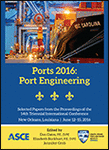The Small-Scale LNG Facility in Rotterdam
Publication: Ports 2016
Abstract
LNG (liquefied natural gas) is expected to become a competitive alternative for conventional fossil fuels for seagoing vessels, in particular for vessels sailing in emission control areas, like the North Sea and Baltic where strict environmental regulations regarding sulphur oxides (SOx) and nitrogen oxides (NOx) are applied, since LNG is the cleanest fossil fuel with the smallest carbon foot print. Also, for barges LNG could be an interesting alternative, since the emission regulations for barges are even stricter than for seagoing vessels. Hence there is also a need for LNG facilities capable of distributing relatively small quantities of LNG. For that reason Gate terminal together with the Port of Rotterdam Authority decided to construct a small scale LNG loading facility, adjacent to the existing gate LNG import terminal. LNG carriers are treated as “regular ships” carrying dangerous cargo in the Port of Rotterdam and the paper briefly describes the Rotterdam standards regarding LNG transport. For this project a new port basin is created (the Yukonhaven) with a new quay wall. The quay wall can be used by one seagoing LNG tanker up to 180 m and smaller vessels as short as a barge of 50 m of length. According to the SIGTTO (the Society of International Gas Tanker and Terminal Operators) guidelines a dedicated LNG basin is developed instead of a jetty parallel to the channel with ongoing ship traffic. The basin lay-out has been studied using a full mission bridge simulator with the involvement of local pilots and tug masters. In addition, state-of-the-art mooring simulations were performed which included the effect of passing vessels in the channel. The new quay wall is the first of a new standard design for Rotterdam quay walls, but with some specific LNG adaptations. The combination of seagoing vessels and inland vessels on the same berth causes challenges, especially the demand by SIGTTO for energy absorbing fenders and the European ADN safety demands for escape routes for the inland barges (see references). ADN requires small stepping distances from barges to shore. For this project the PIANC (Permanent International Association of Navigation Congresses) “Guideline for the Design of Fenders Systems: 2002” is not longer followed on mooring angles and velocities, but results from a large international PIANC organized (MarCom Working Group 145) monitoring campaign are used to design smaller fenders meeting all requirements. In addition, finite element (FEM) calculations were performed to verify the hull strength of the moored vessels and to be able to neglect the allowable hull pressure stated in the PIANC 2002.
Get full access to this article
View all available purchase options and get full access to this chapter.
Information & Authors
Information
Published In
Copyright
© 2016 American Society of Civil Engineers.
History
Published online: Jun 7, 2016
Authors
Metrics & Citations
Metrics
Citations
Download citation
If you have the appropriate software installed, you can download article citation data to the citation manager of your choice. Simply select your manager software from the list below and click Download.
